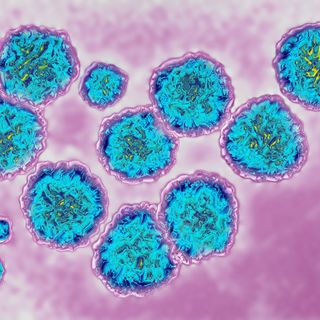
Why Do We Have Moles?
Moles serve no biological function, they are simply a build-up of pigment cells in our skin.

Moles have been imbued with all sorts of meanings across cultures and time. In ancient days, moleomancy was a common practice of divination or fortune-telling via the number and location of moles on the body. But the scientific truth is that moles, far from mystical, are incredibly banal and common — and serve no biological purpose whatsoever.
What are moles?
Moles are concentrations of melanocytes — the skin cells responsible for the color of our skin. When melanocytes fail to spread out evenly and instead grow in clusters or clumps, the skin there often changes color – appearing tan, brown, black, red, pink, or blue — and sometimes has a bump at the site of the build-up. Moles can be congenital, meaning you’re born with them, or formed due to sun exposure.
Are moles normal?
Moles are very normal and anyone can have them, though lighter-skinned individuals are more prone to developing moles. Many babies, of all skin colors, are born with moles, and it’s normal for new moles to appear in childhood and adolescence, all the way up until age 30. It’s also normal for moles to change in size and color across this time — though sudden or significant changes in a mole’s appearance should be monitored.
What causes moles?
While we know what causes moles – melanocyte build-up – it’s not clear what causes melanocytes to clump together. Exposure to ultraviolet radiation (typically from sunlight) is definitely a big catalyst, as UV radiation causes our skin to produce more melanocytes — which is why our skin in general changes color when exposed to the sun.
Genetics also play a major role; moles run in the family for some, and research suggests sex-specific genes are responsible for differences in where moles typically appear on women (lower limbs) and on men (upper body, neck, and scalp). Hormones influence melanocytes as well, with new moles often appearing and disappearing around puberty, pregnancy, and other times of major hormonal fluctuation.
Are moles dangerous?
The short answer: No. Moles have gotten a bad rep amid growing skin cancer awareness, but most moles are not dangerous.
That said, a certain type of mole, called an atypical mole (or, more clinically, a dysplastic nevus), is linked to skin cancer in the following ways. First, the appearance of an atypical mole is very similar to that of cancerous growths indicative of melanoma, a type of skin cancer. This resemblance can lead to the misidentification of cancerous moles as benign, atypical moles, allowing them to go untreated. It’s a mistake common enough that melanoma, which accounts for just 1% of all skin cancers, causes the most skin cancer-related deaths.
Second,having four or more atypical moles is considered a risk factor for skin cancer. And third, atypical moles do have the potential to become cancerous themselves — though it’s rare. Roughly only one in 10,000 atypical moles become cancerous.
Related on The Swaddle:
Everything You Need to Know About Skin Cancer
When to worry about a mole
New moles that appear after age 30 or existing moles that change suddenly in appearance should be examined by a doctor and monitored, as such changes are usually the result of sun-damaged skin rather than genetics or hormonal fluctuation alone. Still, this in itself doesn’t mean the mole is dangerous.
The good news is, it’s relatively easy to tell a basic, non-threatening mole (known as a common mole) from atypical moles and growths indicative of melanoma or other skin cancers. Generally speaking, you don’t need to worry if a mole is: round or oval, flat or raised, a single color (could be tan, brown, black, red, pink, blue, or skin-colored), a consistent texture (could be smooth or rough), and the size of a pencil eraser or smaller. It’s still NEVER a bad idea to see a dermatologist once a year to keep a professional eye on the moles.
Atypical moles, and moles caused by skin cancers usually appear as irregular shapes with uneven borders. They’re usually multicolored — mixtures of tan, brown, red, and pink — and their texture is variegated rather than completely smooth or completely rough. They also tend to be larger in size than a pencil’s eraser. Such moles should be examined by a doctor as soon as they appear and monitored for changes.
Finally, if an existing mole — atypical or common — changes in appearance or size, begins to bleed, ooze, itch, or becomes painful, see a dermatologist as soon as possible.
Who is at risk for a worrisome mole?
Melanin in the skin helps protect it from UV damage. Lighter-skinned people, who naturally have less melanin, are more at risk for developing an atypical mole than those with darker skin, though it is definitely still possible for darker-skinned individuals to get moles and even skin cancer. Individuals who have 50 or more moles, not including moles they were born with, are also more at risk.
Can atypical and cancerous moles be prevented?
The best way to guard against atypical moles and skin cancer is to avoid skin damage from UV rays by wearing full-coverage clothing and/or high SPF sunscreen when in direct or prolonged sunlight. Although this is not a 100% guarantee, it is the most effective way of drastically lowering one’s chances of developing skin cancer.
What happens if you have a worrisome mole?
See a doctor immediately. They may advise monitoring the mole for changes or recommend a biopsy and/or excision.
Related


Why Do We Talk in Our Sleep?
